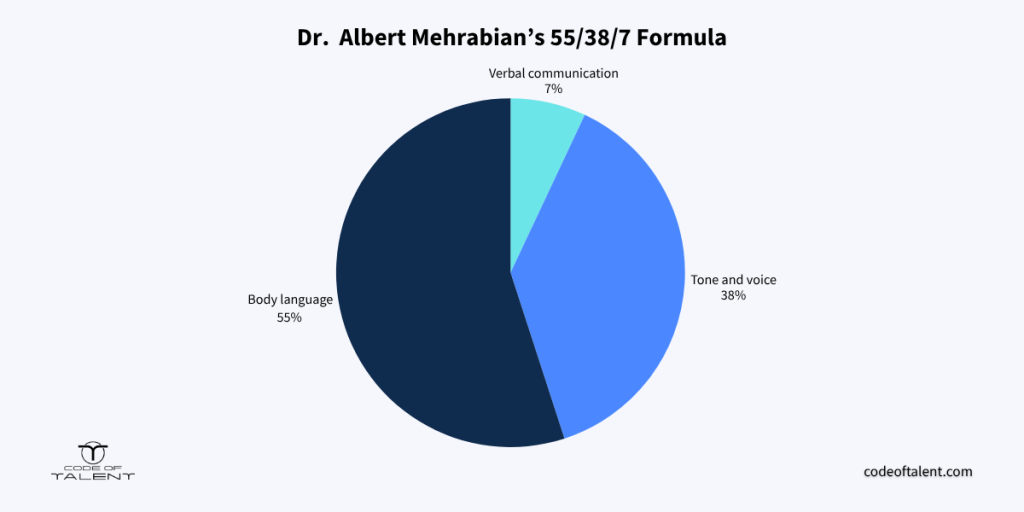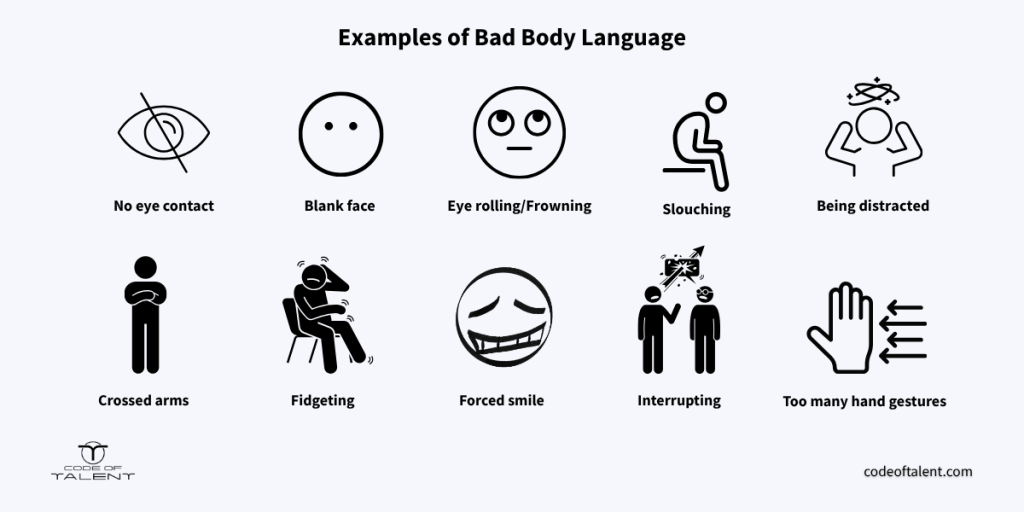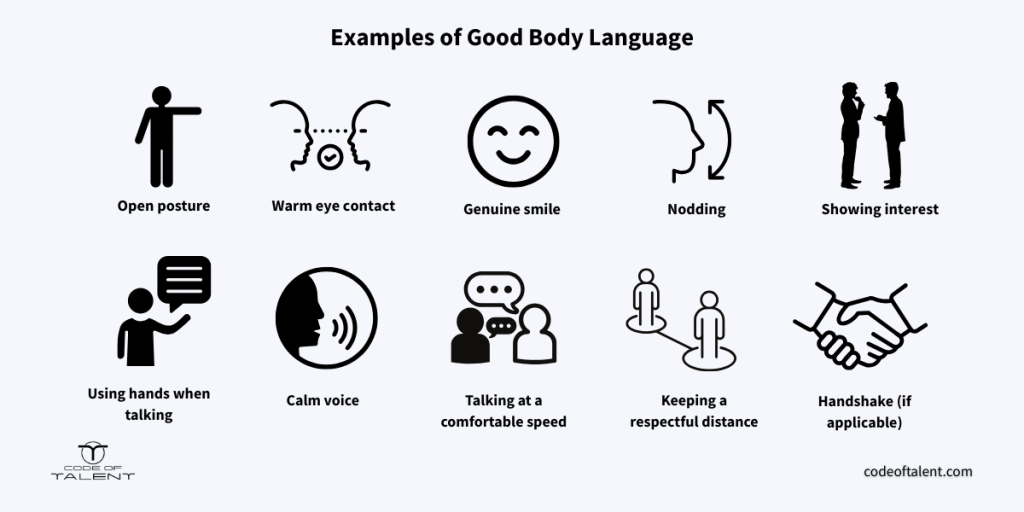Body language in customer service can make or break a first impression, sometimes before a single word is spoken.
Ever checked into a hotel and instantly wanted to leave? The receptionist avoided eye contact or kept most of their attention on their phone rather than your interactions. Would you go back to that hotel? Probably not.
In customer-facing jobs, even small gestures matter. A genuine smile from a waiter can lead to a bigger tip. A slight eye roll from a hairdresser might turn a happy client into a bad online review. These little things, or body language, speak louder than we think. And in customer service, they speak for the whole business.
Why Body Language in Customer Service Matters More Than Words
Words matter. But research shows they’re not everything.
According to UCLA Professor Albert Mehrabian, only 7% of communication is verbal. A staggering 93% comes from non-verbal cues: 38% tone of voice and 55% facial expressions and body language.
This tells us something important: people respond more deeply to how the message is delivered and the physical signals that accompany it.

Effects of Bad Body Language v. Good Body Language
Understanding how body language affects human interactions has been studied for decades by everyone from behavioral psychologists to agencies like the FBI and CIA.
Research shows that these subtle cues not only shape how people see others, but also how they feel about themselves. Our brains read body language automatically, drawing on past experiences and social norms to decide whether someone seems confident, honest, interested, or not.
For example, a study conducted among Iranian learners showed that:
- Posture dramatically affects mood. Participants who held closed postures, such as crossing arms or slouching, reported more feelings of insecurity and sadness.
- Those who adopted open postures experienced more positive moods and engagement.
In terms of understanding why body language in customer service is important, when staff project positivity through body language, it has a contagious effect. Customers feel more relaxed, respected, and safe.
Remember: When customers feel that way, they are more likely to return, refer others, and spend more.
Examples of Bad Body Language in Customer Service
A lot of people use these body language cues without even noticing. But with practice and the right training, they can change over time. Here are some common examples of bad body language in customer service, what they mean, and why they matter.

1. Avoiding Eye Contact
What it shows: Discomfort, distraction, or even dishonesty.
Why it matters: Eye contact helps people feel seen and heard. Without it, customers may feel ignored or unimportant.
What the customer is thinking: “They’re not paying attention to me.” or “They seem shady—what are they hiding?”
2. Blank Facial Expression
What it shows: Boredom or lack of interest.
Why it matters: A flat expression makes it seem like the staff doesn’t care about the customer or the interaction.
What the customer is thinking: “They don’t care about me.” or “I’m just another task for them to get through.”
3. Frowning, Grimacing, or Eye-Rolling
What it shows: Annoyance, frustration, or judgment.
Why it matters: Even a quick eye roll or frown can make a customer feel insulted or judged.
What the customer is thinking: “Did I say something wrong?” or “They clearly don’t want to deal with me.”
4. Poor Posture (Slouching or Leaning Away)
What it shows: Low energy or disinterest.
Why it matters: Good posture signals alertness and professionalism. Slouching sends the opposite message.
What the customer is thinking: “They’d rather be anywhere else.” or “This place feels unprofessional.”
5. Looking at a Phone, Talking to Someone Else, or Turning Away
What it shows: Distraction or a lack of respect.
Why it matters: Dividing attention makes the customer feel unimportant. It also delays service and creates frustration.
What the customer is thinking: “I’m not a priority here.” or “They don’t care if I stay or leave.”
6. Crossing Arms Over the Chest
What it shows: Being closed off or defensive.
Why it matters: Crossed arms can make staff appear unapproachable or unwilling to help, even if they don’t mean it that way.
What the customer is thinking: “They’re not open to what I have to say.” or “This doesn’t feel like a friendly place.”
7. Tapping Fingers, Shifting Feet, or Fidgeting
What it shows: Impatience or irritation.
Why it matters: These small movements may seem harmless but often make people feel rushed.
What the customer is thinking: “They want me to hurry up.” or “I’m annoying them just by being here.”
8. Forced or Inconsistent Smiles
What it shows: Insincerity or a fake attitude.
Why it matters: Customers can tell when a smile isn’t genuine, which breaks trust and creates tension.
What the customer is thinking: “That didn’t feel real.” or “They’re pretending to be nice, but I can tell they’re annoyed.”
9. Interrupting the Customer
What it shows: Impatience or a lack of respect.
Why it matters: Interrupting makes people feel unheard. It signals that their input isn’t valuable.
What the customer is thinking: “They’re not even listening.” or “They just want to get rid of me.”
10. Using Excessive or Overdramatic Hand Gestures
What it shows: Nervousness, lack of control, or even aggression.
Why it matters: Big or overly frequent hand movements can be distracting or overwhelming.
What the customer is thinking: “They’re too much.” or “This feels uncomfortable or tense.”
Examples of Good Body Language in Customer Service
Positive body language reinforces professionalism and care. Here are 10 examples of good body language in customer service, along with why they matter in everyday interactions:

1. Open Posture
What it looks like: Arms relaxed at the sides, shoulders back, facing the customer.
What it shows: Being open and ready to listen.
Why it matters: Makes the customer feel welcome and comfortable.
2. Warm, Steady Eye Contact
What it looks like: Looking at the customer’s eyes often but naturally, not staring.
What it shows: Paying attention and being interested.
Why it matters: Builds trust and keeps the customer involved.
3. Genuine Smile
What it looks like: A real smile that reaches the eyes, not just the mouth.
What it shows: Friendliness and honesty.
Why it matters: Helps customers feel relaxed and happy.
4. Nodding and Copying Some Gestures
What it looks like: Nodding slightly or matching the customer’s tone or movements.
What it shows: Listening closely and understanding.
Why it matters: Shows the customer they are being heard.
5. Facing the Customer Fully and Leaning In a Bit
What it looks like: Body turned directly toward the customer, leaning forward just a little.
What it shows: Interest and focus.
Why it matters: Lets the customer know they have full attention.
6. Using Hand Movements to Explain Things
What it looks like: Gesturing with hands when talking, like pointing or showing size.
What it shows: Confidence and clear communication.
Why it matters: Helps customers understand better and stay engaged. In fact, a study by Colgate University found that people pay more attention when hand gestures are used during conversation.
7. Calm, Even Tone of Voice
What it looks like: Speaking clearly without shouting or whispering.
What it shows: Confidence and control.
Why it matters: Keeps the conversation calm and professional.
8. Speaking at a Comfortable Speed
What it looks like: Talking neither too fast nor too slow.
What it shows: Patience and clarity.
Why it matters: Helps customers follow along without confusion.
9. Keeping a Comfortable Distance
What it looks like: Standing close enough to talk but not too close to make the customer uncomfortable.
What it shows: Respect for personal space.
Why it matters: Makes the customer feel safe and respected.
10. Friendly, Professional Handshake (If Appropriate)
What it looks like: A firm but relaxed handshake, with eye contact and a smile.
What it shows: Courtesy and confidence.
Why it matters: Creates a positive first impression.
How to Use Body Language Effectively in Customer Service Teams
Training employees to use body language intentionally helps reduce negative interactions and build trust with customers. These key strategies can guide your team:
Be Aware of the Situation
Train staff to notice how the customer feels and adjust their behavior.
Example: If a customer seems in a hurry, being too cheerful might seem like not taking them seriously. Staying calm and focused works better.
Learn about Different Cultures
Body language means different things in different places. Knowing these differences helps prevent misunderstandings, which, in the worst case scenario, can also turn into a conflict.
Example: In Japan, sitting cross-legged can be seen as rude, especially in front of someone older. In some parts of Europe, particularly Southern and Eastern regions, people tend to be more expressive and open with physical touch, such as handshakes or a pat on the shoulder. However, in Northern European countries, too much physical contact may feel intrusive or uncomfortable.
Match Gestures to Words
Make sure hand movements and body signals match what’s being said.
Example: Open hands when offering help show honesty. Pointing at someone, however, can feel rude and should be avoided.
Respect Personal Space
Everyone has a different idea of what feels comfortable. Teach staff to notice the customer’s cues.
Example: Lean in when the customer is interested, but step back if they seem uncomfortable.
Mind the Industry
Different industries call for different non-verbal standards. Here’s how body language expectations vary depending on the type of customer-facing business:
Hotels
- Maintaining eye contact during check-in
- Standing upright with arms relaxed at the sides
- Nodding slowly while a guest speaks
Restaurants
- Smiling when approaching a table
- Leaning in slightly when taking orders
- Making brief eye contact without staring
Spas & Beauty Salons
- Soft eye contact paired with a calm tone
- Gentle hand movements
- Maintaining open posture while consulting clients
Retail (Fashion, Electronics, Home Goods, etc.)
- Approaching customers with a smile
- Keeping hands visible and relaxed
- Turning fully toward customers when answering questions
Banking & Financial Services
- Sitting upright and still during consultations
- Using calm hand gestures to explain documents
- Making consistent but respectful eye contact
Logistics & Delivery Services
- Handing off items with brief, clear eye contact
- Offering a nod or short greeting
- Standing tall with neutral expression when waiting
Healthcare & Pharma
- Using slow, deliberate gestures
- Avoiding sudden or exaggerated movements
- Keeping an open stance when speaking with patients
How to Train Staff on Body Language: Best Practices for Managers and Founders
Training employees to use body language well shouldn’t be left to chance. Managers and business owners play a key role in making sure their teams understand how body language affects customer experiences. Below are simple and effective ways to include body language training in everyday operations:
1. Make Body Language Part of Onboarding
Include a dedicated session on body language in the first week of training during onboarding. Go over the basics like standing posture, facial expressions, eye contact, and tone of voice. Make it part of your brand’s standard for service. When people learn it from the start, it becomes a natural part of how they communicate.
2. Go Micro
Instead of bombarding your employees with lots of information about body language in a rushed training session, try something cleverer: microlearning.
Microlearning means breaking down information into small, focused lessons. These could be short videos, flashcards, or quick quizzes, usually taking less than 10 minutes to complete. Instead of long lectures, employees get to learn in bite-sized moments that are easier to remember.
For body language, this might look like:
- A short quiz on what crossed arms or eye contact mean
- A quick video that shows “good vs bad” posture in customer service
- A short prompt asking employees to reflect on their non-verbal habits that day
Because microlearning fits into busy schedules, it helps teams learn faster and retain the information better, especially in fast-paced environments like restaurants, retail, or healthcare.
Code of Talent is such a platform: designed to deliver quick, impactful lessons right when teams need them. See what it can do here.

3. Use Video Role-Plays
Record short service interactions and review them as a team. Watching their own body language in action can help employees understand how they come across to customers. If someone’s not comfortable being filmed, use training videos instead.
4. Create Peer Feedback Sessions
Encourage team members to give each other tips. When done in a supportive way, peer feedback builds trust and helps staff grow together. It also helps everyone stay mindful of how their body language affects others on the team, not just customers.
Feedback can be in-person or online through training/microlearning platforms.
5. Support Self-Awareness Through Reflection
Encourage staff to think about how they carry themselves during customer interactions. This could mean reflecting on how they felt and moved during a shift. Many don’t notice they frown or cross their arms until they see it or think back on it.
Conclusion: Why Body Language in Customer Service Deserves Executive Attention
Body language in customer service isn’t just about how employees stand or smile, but about how customers feel in every moment of an interaction. A slight frown, a crossed arm, or lack of eye contact can change the tone of a conversation and leave a lasting impression. On the other hand, open posture, warm eye contact, and calm gestures can build trust and turn everyday service into memorable experiences.
For managers and business owners, building this awareness across teams takes more than good intentions. It takes structured, repeatable training.
That’s where Code of Talent makes a difference. Our platform doesn’t just help teams master body language or soft skills. It supports continuous learning across multiple areas that drive business performance:
- Customer experience
- Compliance, safety, and risk awareness
- Policies and procedures
- Upskilling for frontline teams and middle management
All through short, interactive learning modules that are easy to follow and fit naturally into daily workflows.
Want to build a customer-facing team that communicates with confidence, clarity, and care?
Start a free trial today and create your own training path from scratch. With the right tools, it’s easier than ever to improve service, communication, and customer satisfaction and master the power of body language in customer service.
Cover photo: Freepik





